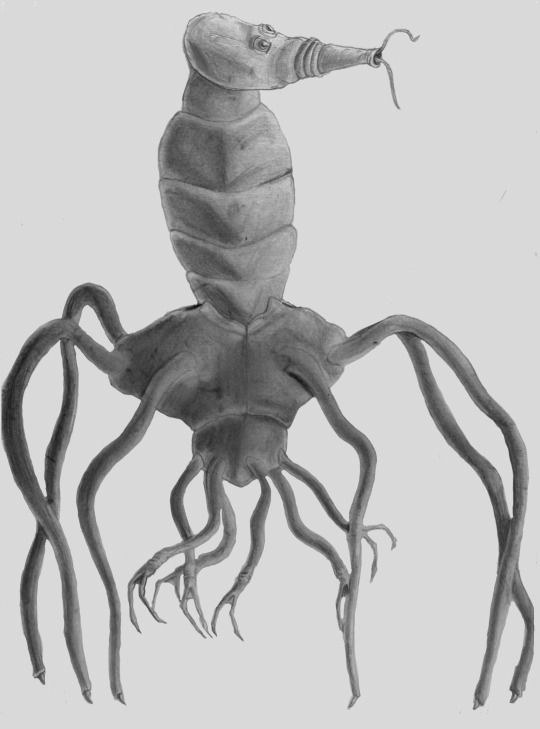Text
If that alien corpse in Mexico turns out to be real (it's not), then I'm gonna be so pissed. It's such a boring and cliched humanoid design.
1 note
·
View note
Text
A Cthornat

2 notes
·
View notes
Text
An Ullret

8 notes
·
View notes
Text
A Thwallox
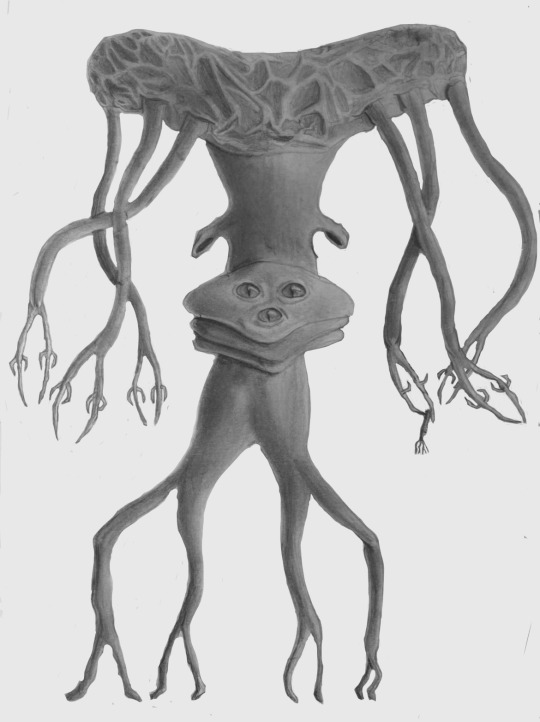
3 notes
·
View notes
Text
A Robot Worker

6 notes
·
View notes
Text

One of these groups was protected from warfare by the dense nebula around their solar system.
They evolved into the Cullretz. On their primary homeplanet, they faced freezing temperatures and the competition of large animals. As a result, they had developed large bodies with immense pack heat.
One would think that the Cullretzes would have a hard time keeping their balance. One would be wrong. While their main body had lots of pack heat in the form of lots of fat, this fat was very light.
The Cullretzes evolved into a variety of different creatures…
On the other side of the planet, a huddle of mountains gathered. Amid the towers of stone lived the Iretzik.
Their ears lengthened to work like sails, catching the wind and propelling them forward as they hunted.
8 notes
·
View notes
Text
Overtime, the two of them evolved into two different pairs. One of these pairs were the Aenods and the Tongues.
The Tongues would connect to the Aenod’s digestive tracts, so they could eat for them. The mouth of an Aenod was always open, their jaws always unlocked.
The Aenods were thrice the size of a blue whale.

The other pair were the Abysswalkers and the Silnks. The Silnks re-evolved the clawed fingers of the Miners, and they used them to walk. They had a method of sticking them out of the Abysswalkers, and then emitting a liquid that would seal the wound shut. By doing this, the Abysswalkers were given a pair of legs for walking on the bottom of the ocean floor.

In the seas of Drornia were massive forests of Lonshen. These were similar to kelp, but far larger and taller, reaching from the bottom of the ocean to above the surface of the water.
A group of humans began living in the Lonshen, hollowing them out to convert them into massive houses. Over time, they evolved into the Slings, their bodies becoming longer so as to sling themselves from different Lonshens. The Slings were also skilled in the art of holding their breath.
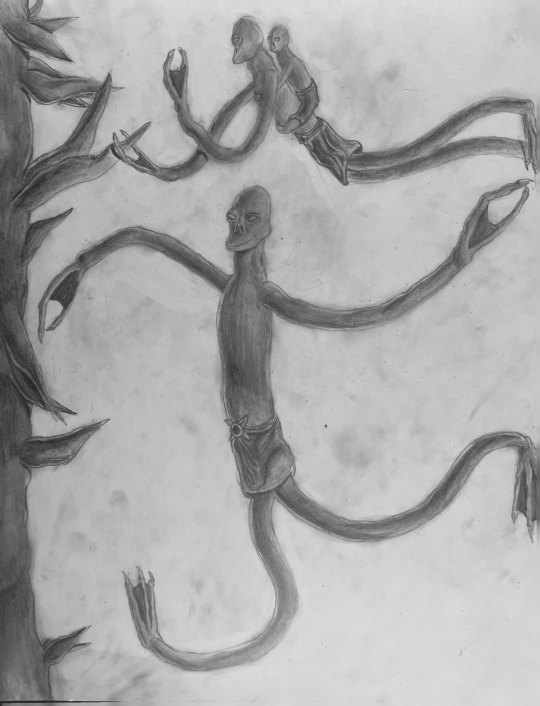
Also underwater were extraordinarily massive whale-like creatures known as Marinats. Some humans found they could live inside these beings. The humans would interact with the Marinat’s brains to control their movements. They would also hollow out the Marinat’s tentacles to connect with other groups of Marinat dwelling humans.
Overtime, the humans inside evolved into the Operators. Their limbs disappeared so that they could swim through the many tunnels inside a Marinat's body. They developed a way to extend their nervous system outside their bodies through their mouths, then connect it to the Marinat’s brains. That way, they could meld their consciousnesses through mycosis.
The Operators did not breathe in, but instead sucked up the oxygen inside of the Mariant’s blood.
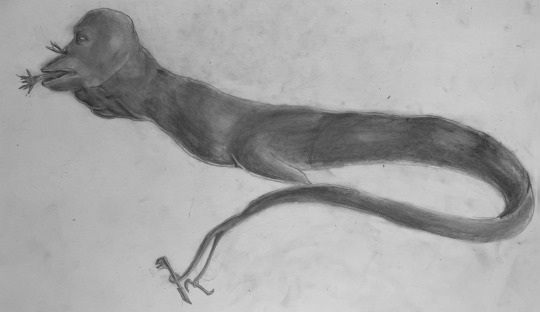
Drornia
In this universe, humanity's exodus from their home solar system went differently.
A group of miners and humans went to Drornia, a planet with 87% of its surface covered with water.
It was difficult to live above the water on Drornia, mostly due to a creature known as the Filxat. This creature would capture animals and then inject them with its eggs. These eggs would be covered with a chemical solution that slowly mutated any being injected with the eggs. They would become bloated, their limbs fusing with their body. Their bones would dissolve, rendering them immobile. When they were nothing more than a massive hunk of flesh, the eggs would hatch. The larva would then eat the giant mass of flesh.


The Filxat could not swim, and as a result, the humans and Miners on the planet would stay near the ocean. Overtime, they would get the adaptations required to live inside the ocean full time.
The humans evolved into many different creatures, including the Balinettes. However, the Miners only evolved into one species, the Madeels.
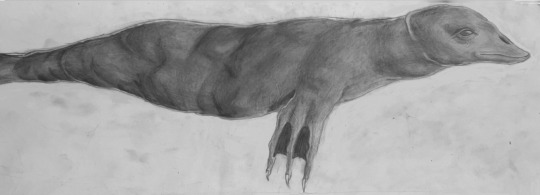
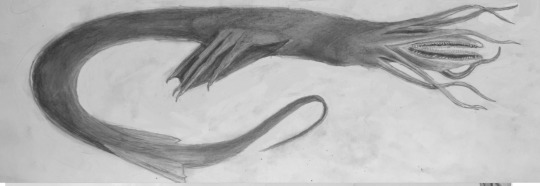
The Balinettes were similar to the whales of old. They were covered with a thick layer of blubber which provided insulation, and their throat could expand to take on large amounts of seawater filled with small creatures. Not only that, but they were about the size of a blue whale.
Also similar to whales, Balinettes had the ability to hold their breath for long periods of time.
The Madeels formed a symbiotic relationship with the Balinettes, where the Madeels would eat the Balinettes tongue, then take the place of said tongue. The Madeels would then control the Balinettes from their mouths. The tentacles of the Madeels allowed for tool usage that the Balinettes were otherwise incapable of.
2 notes
·
View notes
Text
Drornia
In this universe, humanity's exodus from their home solar system went differently.
A group of miners and humans went to Drornia, a planet with 87% of its surface covered with water.
It was difficult to live above the water on Drornia, mostly due to a creature known as the Filxat. This creature would capture animals and then inject them with its eggs. These eggs would be covered with a chemical solution that slowly mutated any being injected with the eggs. They would become bloated, their limbs fusing with their body. Their bones would dissolve, rendering them immobile. When they were nothing more than a massive hunk of flesh, the eggs would hatch. The larva would then eat the giant mass of flesh.


The Filxat could not swim, and as a result, the humans and Miners on the planet would stay near the ocean. Overtime, they would get the adaptations required to live inside the ocean full time.
The humans evolved into many different creatures, including the Balinettes. However, the Miners only evolved into one species, the Madeels.


The Balinettes were similar to the whales of old. They were covered with a thick layer of blubber which provided insulation, and their throat could expand to take on large amounts of seawater filled with small creatures. Not only that, but they were about the size of a blue whale.
Also similar to whales, Balinettes had the ability to hold their breath for long periods of time.
The Madeels formed a symbiotic relationship with the Balinettes, where the Madeels would eat the Balinettes tongue, then take the place of said tongue. The Madeels would then control the Balinettes from their mouths. The tentacles of the Madeels allowed for tool usage that the Balinettes were otherwise incapable of.
2 notes
·
View notes
Text
Ants and Humans of Kepler 22B, a Beyond the Stars Alternate Timeline

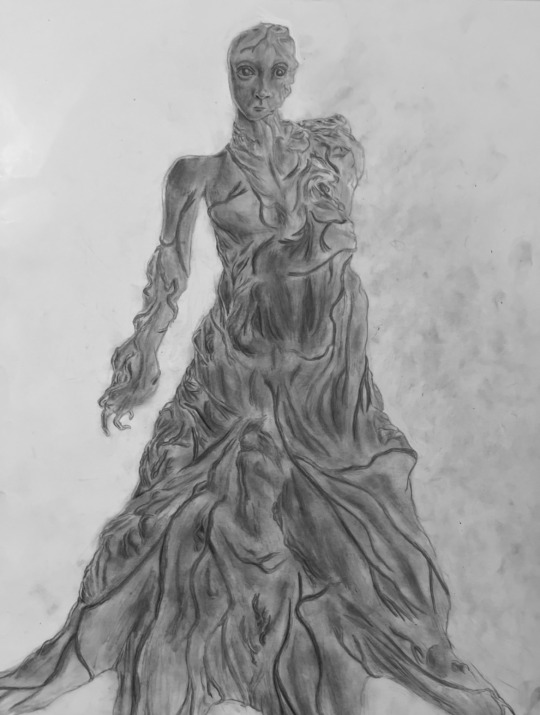
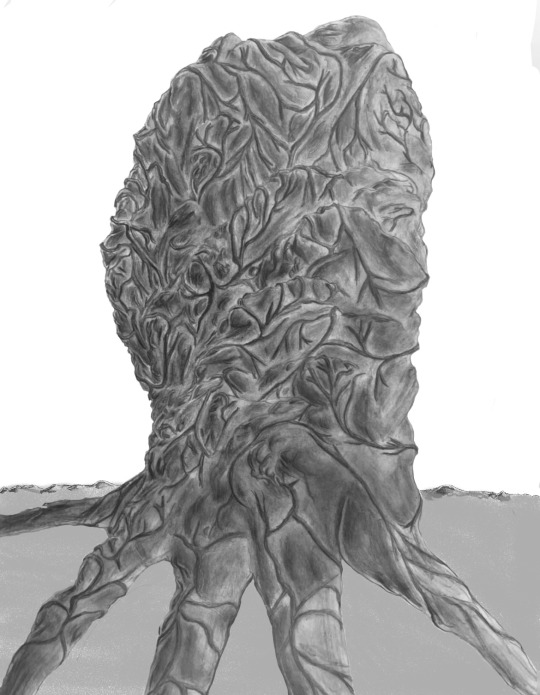
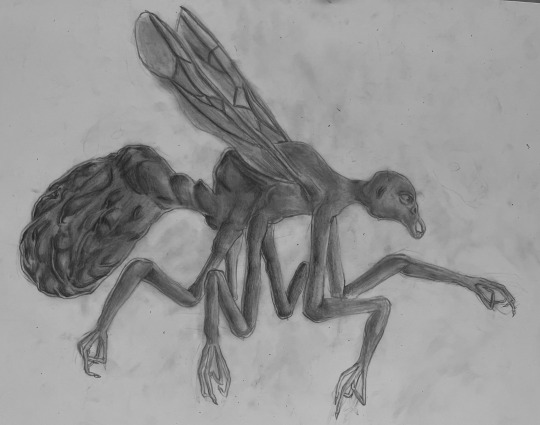
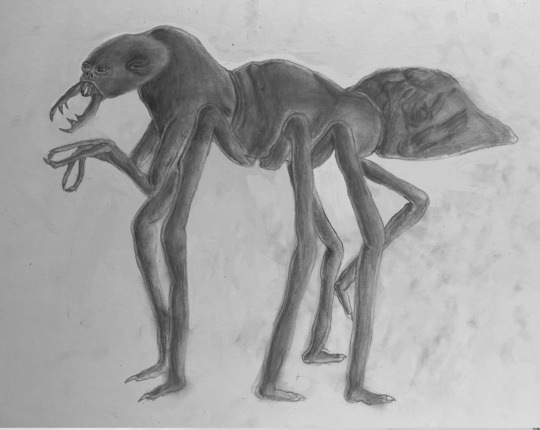
In this universe, the humans from Venus kidnapped some ants for scientific purposes before they left their home.
When they landed in their new home of Kepler 22B, the ants escaped. Over the course of thousands of years, the ants would evolve into parasitic beings. Up to three or four ants would bite a human and then travel to their brain, where they would take control of all their motor functions.
Overtime, the ants would rewrite the human’s DNA, turning them into a Mech. Mechs were twice as tall as humans, with an extra pair of limbs and various ant-like features. The mind of the human would still reside in The Mech, but it was the ants who were in control of all movements.
There were some humans with only one ant in them. These were the queen ants. Human hosts with a queen inside them would grow into massive biological structures known as Hive Towers. These structures would connect to each other, forming tunnels that could transport nutrients and allow different queens to communicate. The Mechs would live inside the Hive Towers.
At the center of every Hive Tower would be a massive white pillar that had once been the queen. The white pillar connected to the Hive Tower as a whole, allowing the queen to control all of the Hive Towers functions. The various tubes sticking out of the white pillar would transport pheromones through the Hive Tower and then emit them through spigots. This allowed the queen to send messages throughout the Hive Tower.
Overtime, ant mechs developed the ability to place ant eggs inside a human through a bite. Using this, the ants were able to spread throughout the world like a disease, converting every human they found.
The ants began realizing that a much better method would be to capture all humans and keep them in farms inside the Hive Towers. That way, they could be bred, and then transformed.
The Hive Towers developed specific parts that could inject eggs of queens into certain humans. These humans would then be taken outside so that they could turn into a new Hive Tower.
Eventually, the entirety of Kepler 22B was covered with Hive Towers. Inside them lived the Mechs, which could now have dozens of ants in them. Humanity on this planet were nothing more than cattle, with the ants forming civilizations by using their bodies.
The ants began to figure out how to purposefully mutate their human mechs- leading to all sorts of creations.
There were the Tanks, massive Mechs with eight limbs that could carry Mechs from place to place.
When fighting with each other, the ants would use Fighter Mechs, large Mechs with claws and wings.
This is all part of the alternate Drornia universe, a different timeline of the main Beyond the Stars universe.
7 notes
·
View notes
Text

A couple hundred years passed, it was the year 2916, and the solar system had become a vastly different place. The entirety of Mars was in the nonexistent hands of The Servers, who had uploaded their minds into digital space.
Martian society was unique. The implants were still in people's brains, but instead of allowing them to buy emotions, they prohibited all emotions from entering a Martian's mind. The entire goal of the Martians lives was the further advancement and development of their society. Every Martian was filled with one singular desire: a future where The Servers controlled the entire universe and logic ruled over all. Their hopes lead them to begin building a massive band around the circumference of the Sun known as a Dyson Sphere. If everything had worked out, the Dyson Sphere would have harnessed the vast energy of the sun so that the Martians could have used it for space travel.
The reason for all of this was that the distortion of the Servers' minds was so extreme that they no longer saw themselves as human beings, but as parts of a god-like computer. Anyone could see that they were wrong, but there was no one around to tell them that they were being egotistical. The Servers were afflicted with the obsession of burning away all chaos in the universe and replacing it with nothing but logic and order. This, in their minds, would make everything be perfect.
2 notes
·
View notes
Text
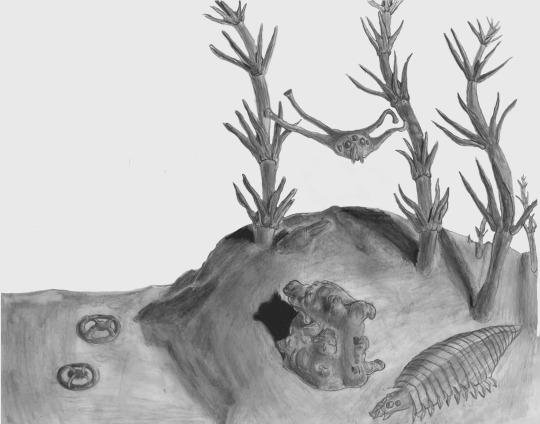
In the outer rim of the galaxy was a planet called Lhrue that was overflowing with life.
On the waves of the pale blue oceans floated the Aringogs, pushed back and forth by the quivering hands of the wind. The wind would stumble onto the surface where it mixed with the steam that spurted out of the holes of the Steambulbs. When the wind struck the ground a certain way, it would kick up the red sand into the air, painting it a soft pink.
This red sand that covered the ground was a dark crimson where the Perpetualets carved their sharp shadows onto it. A single Perpetualet would be made of multiple plants. When one of these plants got big enough, a small one would grow from it, and its growth would eventually push the larger one down into the ground. This eternal cycle gave the Perpetualets their name.
The long legs of the Spindles would let them swing between the Perpetualets as they searched for prey.
The unknowable words that the wind whispered were occasionally punctuated by the popping noises from the Exploding Aubders. The outgrowths that grew on them would pop when they got too big, sending seeds outwards.
0 notes
Text
A Land and a Water Siphonocyst
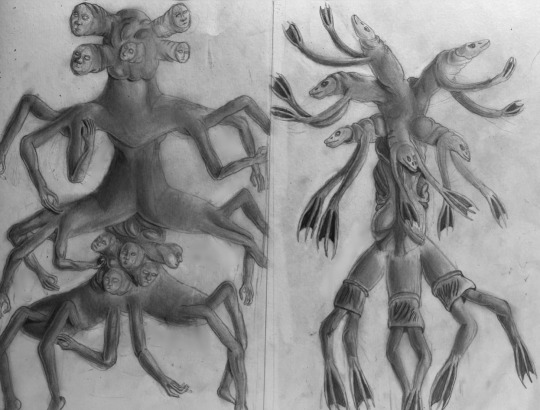
You may remember how there were various humans who fled Sianda.
This group of refugees found another planet, and overtime they propagated, their numbers growing. The new planet they found was a strange one, in that it had been populated long ago. However, its inhabitants had destroyed each other in a war.
The planet was not easy to survive on, as mass war is rarely beneficial towards ecosystems. However, humanity never met a challenge that it could not overcome, and the refugees managed to turn the strange planet into a new home.
To survive, the humans had to work together, and overtime, their empathy became more acute. This led to organic telepathy, which then led to hive minds.
Over the passing of millions of years, they evolved to become the Siphonocysts, colonies made up of individual parts known as Zooids. Stems of diploblastic tissue connected these Zooids to each other.
Each Zooid had a specific specialized function within a Siphocyst colony.
There were many different types of Siphonocysts.
A Land Siphonocyst would seldomly move. Instead, they would stand completely still. Their appearance was similar to a type of tree on the planet, so various stupid creatures would mistake them for trees. When these creatures landed on a Land Siphonocyst, their fate would be sealed.
An Aquatic Siphonocyst would stream gracefully through the water, all of the zooids acting in perfect synchronization. It would feed on small underwater animals, the sharp teeth of the gastrozooids chewing the animals up, then sending the material to other zooids to be digested
4 notes
·
View notes
Text
Nimajneb
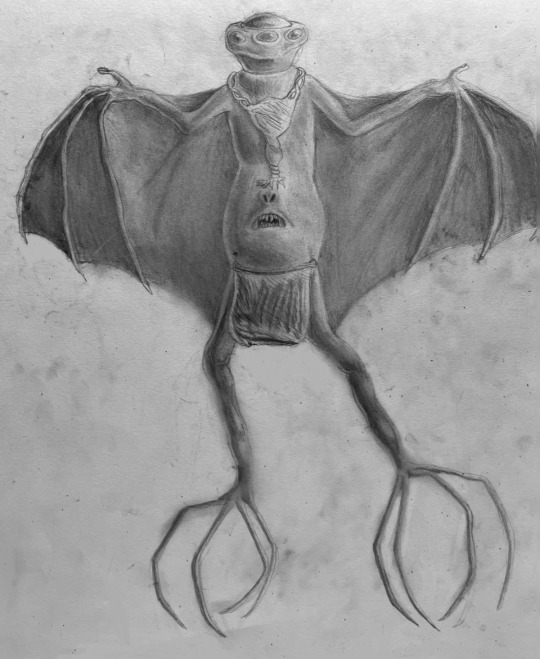
The Titanites built some ships and flew past the outskirts of infinity. They landed in a strange new home. This planet, known as Dici-4, was a steaming hot planet with a salt soaked surface. Salt essentially took the place that rocks had on Earth, while rocks took the place of life.
The lifeforms on Dici-4 were silicon based, not carbon based, as organisms on Earth were. Well, to be pedantic, they were partially silicon based. The life forms on Dici-4 were made up of a mix between silicon based and carbon based cells. The carbon cells dealt with energy absorption and retention (the consumption, digestion, and excretion of nutrients). Meanwhile, the silicon cells dealt with everything else (mobility, sensory, reproduction, the consumption of oxygen, et cetera).
There was little water on this planet, but a large abundance of heat. Not only that, but only the carbon parts of lifeforms could be digested, which meant that the Titanites had to survive on less nutrients. Thankfully, the vast amount of salt meant that they always had seasoning.
The planet would get extraordinarily bright during the day, with the gusts of light the sun breathed sparking a shine from the salt and the creatures. However, the absence of a moon meant that the darkness of night was especially fierce on the planet. As a result, the Titanites would go out only during evening and dusk. Over time, they developed eyes that could see better in both darkness and light. However, they still continued their previous sleep schedule, as it was what they were used to.
Other changes to their eyes included the addition of a third one. This gave them a broader sense of vision which they needed to deal with The Flying Leeches. They were exactly what they sounded like. Best described as a mix between a dragonfly and a leech, the Flying Leech would have been a fearsome predator even if it wasn’t five feet long.
Eventually, the Titanites became the Nimajnebs.
3 notes
·
View notes
Text
An Astrosymbio

The Astrosymbios were the size of cities, measuring hundreds of kilometers.
They could be thought of as massive ant farms flying through space. There were two parts to an Astrosymbio: the Pilots (descendants of the Nomads), and the Stellans (descendants of the Habitats). In the Stellans interior were massive caverns and tunnels. On the walls of these tunnels would grow sacks, out of which would come Pilots. Each Pilot had a specific purpose within the Stellan, like a cell within a body. The Stellans would get their energy from sunlight, and get water from ice crystals floating in asteroid belts. This energy and water would be given to the Pilots through the various plants that grew in the interior of the Stellans. The Stellans could be thought of as massive factories, with machines made of flesh worked on by the Pilots. Every part of this factory shared one mind.
To reproduce, a bunch of Pilots would be ejected into space. There, their bodies would clump up and turn into an egg. This egg would travel into a sun, where it would incubate for about 50 years or so before hatching with an Astrosymbio.
Once born, the Astrosymbio would expect a life spanning thousands of years, wandering through space. One hobby the Astrosymbios often indulged in to stave off boredom was the molding of nebulas into art. By using their abilities to warp spacetime around them, the Astrosymbios could move the cosmic dust into new and intriguing patterns.
3 notes
·
View notes
